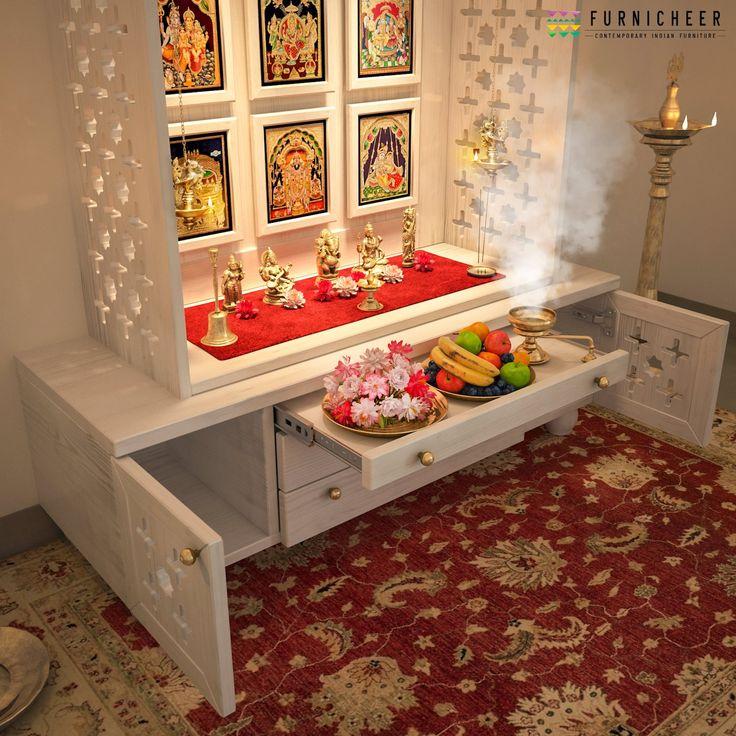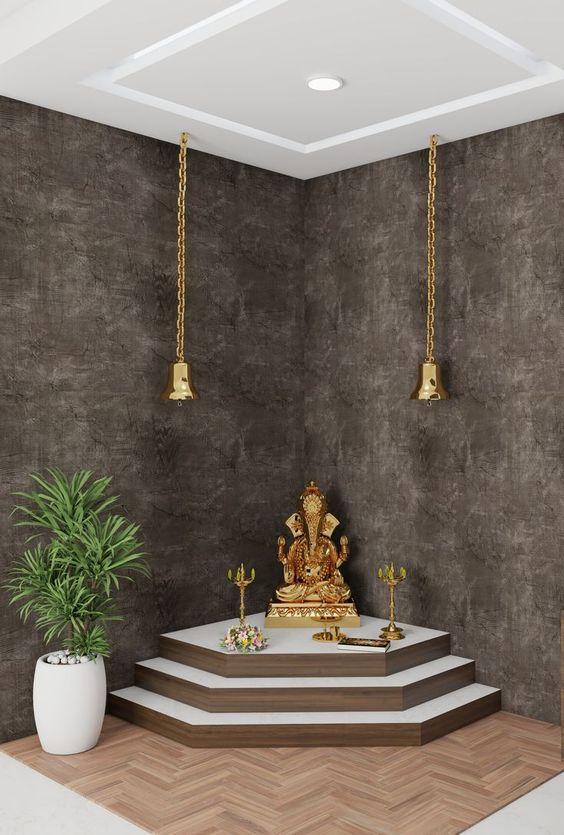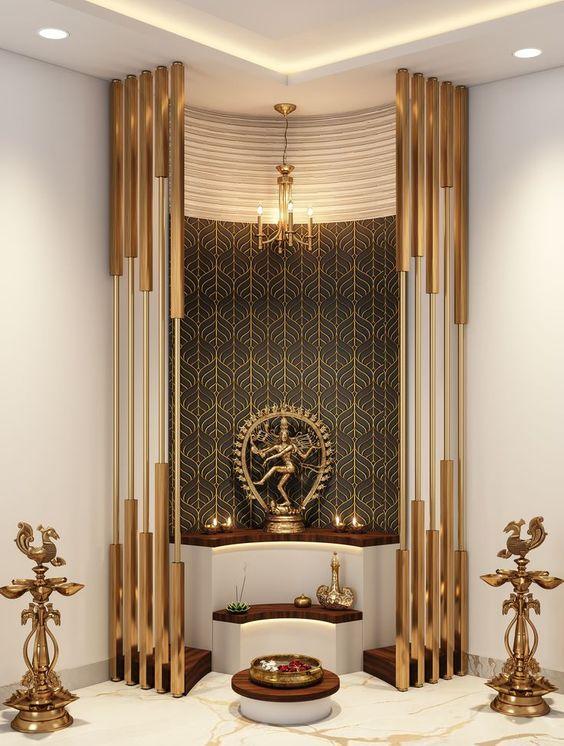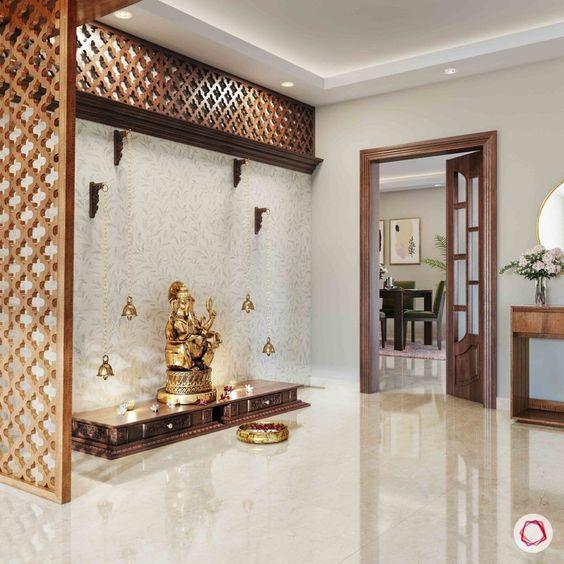



Table of Contents
- Introduction
- Types of Pooja Rooms
- Essential Elements of Pooja Room Design
- Pooja Room Door Designs
- Placement of the Pooja Room
- Creating the Perfect Ambiance
- Innovative Storage Solutions
- Accessories and Decor
- Practical Tips for Designing a Pooja Room
- Conclusion
- Faq's
Introduction
In Indian homes, the Pooja room stands as a sacred sanctuary, a dedicated space for prayers, meditation, and worship. This room is more than just a physical space; it's a haven of tranquility, where one can connect deeply with the divine. As home designs evolve, Pooja room designs are also transforming, skillfully merging traditional elements with contemporary aesthetics. This article explores the multifaceted world of modern Pooja room designs, offering insights into how to create a space that honors tradition while embracing modern design principles. Whether you're looking to incorporate traditional motifs or prefer a sleek, minimalist approach, we will guide you through various aspects of designing a Pooja room that enhances the spiritual ambiance of your home.
Types of Pooja Rooms
Traditional Pooja Rooms
Traditional Pooja rooms are the epitome of timeless elegance and spiritual reverence. These spaces are often enclosed, providing a secluded area dedicated entirely to worship. The design elements in traditional Pooja rooms include:
 Traditional Pooja Room
Traditional Pooja Room
Image Source: Pinterest
- Intricate Wooden Carvings: The use of elaborately carved wooden panels and doors is a hallmark of traditional Pooja rooms. These carvings often depict religious symbols, deities, and floral motifs, adding a rich cultural and spiritual essence to the space.
- Ornate Doors: Traditional Pooja room doors are usually heavy and intricately designed, often featuring brass or other metal embellishments. These doors serve as a grand entrance to the sacred space, marking the transition from the mundane to the divine.
- Natural Materials: The emphasis on natural materials like wood, stone, and brass is prominent. Wooden altars, stone flooring, and brass lamps contribute to a serene and timeless appeal. These materials not only enhance the aesthetic but also imbue the room with a sense of purity and permanence.
- Classic Motifs: The decor often includes classic Indian motifs such as rangoli patterns, traditional wall hangings, and religious paintings. These elements create a deeply immersive spiritual environment, reflecting the rich heritage and traditions of Indian culture.
Contemporary Pooja Rooms
 Contemporary Pooja Room
Contemporary Pooja Room
Image Source: Pinterest
Contemporary Pooja rooms are designed to align with modern home aesthetics while maintaining a spiritual core. Key features include:
- Clean Lines: Contemporary designs prioritize clean, straight lines and simplicity. This minimalist approach helps in creating a clutter-free and peaceful environment conducive to meditation and worship.
- Modern Materials: The use of materials such as glass, metal, and engineered wood is common in contemporary Pooja rooms. These materials provide a sleek and sophisticated look, blending seamlessly with modern interiors.
- Innovative Lighting: Lighting plays a crucial role in contemporary Pooja rooms. Recessed lighting, backlit panels, and strategically placed LED lights are used to highlight the deities and enhance the overall ambiance. This modern lighting approach can create a warm and inviting atmosphere while focusing attention on the sacred elements.
- Sleek Finishes: The finishes in contemporary Pooja rooms are often smooth and polished, giving a refined look. From glossy marble floors to metallic accents, these elements add a touch of elegance and modernity.
Compact Pooja Corners
 Compact Pooja Corner
Compact Pooja Corner
Image Source: Pinterest
For those living in smaller apartments, compact Pooja corners offer a practical yet sacred space for worship. Features include
- Utilizing Niches: Small niches in walls or unused corners can be transformed into Pooja spaces. These niches can be adorned with shelves and small altars to hold idols and other worship essentials.
- Wall-mounted Shelves: Wall-mounted shelves are an excellent solution for creating a dedicated worship area without taking up floor space. These shelves can be customized to hold all necessary items, from idols to incense holders, ensuring that everything has its place.
- Flexible Design: Compact Pooja corners can be designed to blend with the overall decor of the living space. Using elements like foldable screens, curtains, or sliding doors can help in creating a flexible space that can be easily accessed and closed off when not in use.
- Multi-functional Spaces: In small homes, the Pooja corner can also serve as a space for meditation or quiet reflection. Incorporating a comfortable seating arrangement or a small mat can make this area multifunctional.
Open Pooja Spaces
 Open Pooja Space
Open Pooja Space
Image Source: Pinterest
Open Pooja spaces are integrated within the home's interior, often becoming a part of the main living areas. Characteristics include:
- Seamless Integration: These Pooja spaces are designed to blend seamlessly with the rest of the home decor. Elements such as consistent color schemes, matching materials, and similar design motifs help in creating a cohesive look.
- Flexible Elements: Using folding doors, curtains, or movable screens allows these spaces to be flexible. They can be opened up during prayer times and closed off when needed, ensuring privacy and maintaining the sanctity of the space.
- Decorative Integration: Open Pooja spaces often feature decorative elements that enhance both the spiritual and aesthetic appeal of the home. Wall-mounted idols, backlit panels, and decorative niches are common features.
- Accessibility: Located in areas like living rooms or hallways, open Pooja spaces are easily accessible to all family members. This encourages frequent use and ensures that the space remains a central part of the household's spiritual life.
Essential Elements of Pooja Room Design
Idols and Deities
The placement and selection of idols are crucial. Traditional Pooja rooms often have a central idol or a group of deities placed on a pedestal or altar. Modern designs might use a single focal deity with minimalist decor around it.
Lighting
Proper lighting is vital in a Pooja room. Traditional rooms use oil lamps and candles, while modern designs incorporate LED lights, recessed lighting, or backlit panels to highlight the deity and create a serene atmosphere.
Materials
Traditional designs utilize wood, brass, and natural stone, while contemporary designs may incorporate glass, stainless steel, and engineered wood. The choice of materials significantly impacts the room's aesthetic and ambiance.
Decorative Elements
Traditional Pooja rooms often feature carvings, rangoli designs, and floral decorations. Modern Pooja rooms might include abstract art, sleek wall decals, or minimalist sculptures that resonate with spiritual themes.
Pooja Room Door Designs
Wooden Doors
Wooden doors are a staple in traditional Pooja room designs. They can be intricately carved with religious motifs and symbols, offering a grand entrance to the sacred space. High-quality woods like teak and rosewood are commonly used, adding durability and elegance. Traditional embellishments like brass handles and bells enhance the spiritual ambiance.
Glass Doors
Glass doors are popular in contemporary designs. Often frosted or etched with religious symbols, they allow visibility while maintaining a sense of enclosure. The transparency of glass doors brings in light, creating an open and airy feel, while the frames can be customized to blend with the home's decor.
Sliding Doors
Sliding doors save space and are ideal for small apartments. They do not require extra space to open, making them practical for compact areas. Sliding doors can feature traditional or modern elements, with materials ranging from wood to glass, offering a flexible design that suits various aesthetics.
Double Doors
Double doors add a sense of grandeur and are suitable for larger Pooja rooms. They provide a wide, welcoming entrance and can be customized with intricate carvings, etched glass, or sleek modern finishes. Double doors enhance the room's aesthetic appeal and allow for easy accessibility during larger gatherings or rituals.
Placement of the Pooja Room
Vastu Shastra Considerations
According to Vastu Shastra, the Pooja room should ideally be placed in the northeast corner of the house. This direction is considered auspicious and is believed to enhance positive energy.
Also Read: Vastu Approved Wall Colors For Home
Functional Placement
In modern homes, practicality is also considered. The Pooja room should be in a quiet and clean area, away from clutter and noise. It should be easily accessible to all family members.
Creating the Perfect Ambiance
Color Schemes
Traditional Pooja rooms often use earthy tones like beige, brown, and gold, which evoke a sense of warmth and serenity. These colors are typically associated with the earth and nature, grounding the space in spiritual tranquility. Additionally, accents of gold and bronze add a touch of opulence and reverence, enhancing the sacred atmosphere. Modern designs, on the other hand, might incorporate a broader palette, including white, pastels, or even bold colors like red and blue. White and pastel shades create a calm and peaceful environment, perfect for meditation and worship, while bold colors can make a striking statement, reflecting a more personalized and contemporary aesthetic.
Flooring
Marble or granite flooring is common in traditional Pooja rooms for its durability and easy maintenance. These materials are not only long-lasting but also add a touch of elegance and purity to the space. Marble, with its smooth and cool surface, is particularly revered for its association with sanctity and cleanliness. In contemporary designs, flooring options expand to include wooden floors or ceramic tiles with intricate patterns. Wooden flooring introduces a warm and natural feel, aligning with minimalist and eco-friendly design principles. Ceramic tiles, especially those with intricate patterns or religious motifs, can add a unique and personalized touch, combining practicality with aesthetic appeal.
Wall Treatments
Walls in traditional Pooja rooms may feature murals, religious paintings, or textured finishes. These elements create a rich and immersive environment, reflecting the spiritual and cultural heritage of the household. Murals depicting scenes from scriptures, religious paintings of deities, and textured finishes like stucco or clay can add depth and character to the room. In modern designs, wall treatments often include wallpapers, minimalist decals, or backlit panels to enhance the room's spiritual ambiance. Wallpapers with subtle patterns or serene landscapes, minimalist decals with sacred symbols, and backlit panels that create a soft, glowing effect can transform the space into a contemporary yet spiritually uplifting environment. These modern touches allow for creativity and flexibility in design while maintaining the sanctity of the Pooja room.
Innovative Storage Solutions
Built-in Shelves
Built-in shelves provide ample storage for religious texts, puja items, and decorative elements. They can be designed to blend seamlessly with the room's decor.
Cabinets and Drawers
Cabinets and drawers help keep the Pooja room organized. Traditional designs may use ornate wooden cabinets, while modern designs favor sleek, minimalist storage solutions.
Wall-mounted Units
Wall-mounted units are perfect for compact Pooja corners. They save floor space and can be designed to hold all essential items.
Accessories and Decor
Puja Thalis and Bells
Traditional Pooja rooms feature brass or silver Puja thalis (plates) and bells. Modern designs might include these items in more contemporary materials or styles.
Incense Holders and Diyas
Incense holders and diyas (lamps) are essential for creating a serene ambiance. They can be traditional brass or modern ceramic designs.
Floral Decorations
Flowers are an integral part of Pooja room decor. Traditional designs use fresh flowers and garlands, while modern designs might incorporate artificial flowers or floral motifs.
Practical Tips for Designing a Pooja Room
Ventilation
Ensure proper ventilation to allow the fragrance of incense and flowers to circulate. Windows or exhaust fans are essential in both traditional and modern Pooja rooms. Proper ventilation helps maintain a fresh and pleasant atmosphere, preventing the build-up of smoke from diyas and incense sticks. Additionally, incorporating natural ventilation through windows allows for the flow of positive energy, enhancing the spiritual ambiance of the room. If windows are not feasible, consider installing a small exhaust fan or an air purifier to keep the air clean and breathable.
Maintenance
Keep the Pooja room clean and clutter-free. Regular maintenance of idols, lamps, and other items is essential to maintain the sanctity of the space. Dusting and wiping down surfaces, polishing brass or metal items, and changing the flowers regularly contribute to a pristine environment. Decluttering the room by organizing Pooja items in cabinets or on shelves ensures that the space remains orderly and inviting. Using easy-to-clean materials for flooring and wall treatments can also help in maintaining the room's hygiene and appearance with minimal effort.
Personalization
Personalize the Pooja room with elements that resonate with your spiritual beliefs and practices. This could include family heirlooms, personalized altars, or custom-made idols. Incorporating items that hold sentimental or spiritual significance can deepen your connection to the space. For example, a hand-me-down lamp or a special cloth used for rituals can add a personal touch. Additionally, consider adding elements like framed photographs of gurus, scriptures, or even small plants that symbolize growth and life, enhancing the room's personal and spiritual essence.
Conclusion
Designing a Pooja room involves a careful blend of tradition and modernity. Whether you prefer a classic, ornate Pooja room or a sleek, minimalist worship space, the key is to create an environment that fosters spirituality and peace. By incorporating traditional elements with contemporary design principles, you can create a sacred space that aligns with your aesthetic preferences and spiritual needs. With the right design, your Pooja room can become a haven of tranquility and a centerpiece of your home's spiritual life. Consider the tips and ideas discussed in this article to create a Pooja room that reflects your devotion and enhances the spiritual ambiance of your home.
explore further
Latest from Contemporary ideas
More from Innovations
Resources
Dwello, for every home buyer, is a way to go from 'I feel' to 'I know', at no extra cost.




